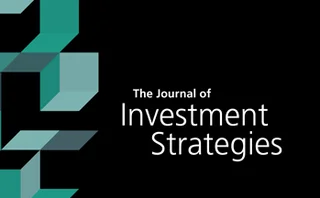Journals
An empirical study on credit risk management: the case of nonbanking financial companies
The aim of this paper is to predict future default behaviors of nonbank financial company customers using credit scores.
Why are investors’ mutual fund market allocations far from optimal?
In this paper, the authors analyze why the optimal portfolio of funds that investors may take under complete information and the actual structure of the mutual fund market differ.
Benefits and risks of central clearing in the repurchase agreement market
In this paper, the authors quantify the potential direct economic benefits to market participants and increased risks to CCPs of moving bilateral repo transactions between US dealers and their nondealer clients to CCPs.
Empirical assessments of the Reserve Bank of India’s policy measures on payment and settlement systems in India
This paper empirically evaluates the effects of policy measures used by the Reserve Bank of India (RBI) on interbank payment and settlement systems in that country.
Bermudan swaption model risk analysis: a local volatility approach
This paper seeks to contribute a simple and (almost) model-free way of assessing the economic value of the Bermudan exercise right derived from a “minimal” local volatility enhanced interest rate model.
Optimal allocation of model risk appetite and validation threshold in the Solvency II framework
In this paper, the authors derive an analytical solution for sub-SCR VTs starting with a model risk appetite (MRA) that defines acceptable errors for an insurer’s total SCR.
A new model for bank loan loss given default by leveraging time to recovery
In this paper, the author estimates a two-equation system: one for LGD that incorporates time to recovery as one of the model explanatory variables, and the other for time to recovery using survival models that address data censoring.
Risk monitoring through better knowledge-based risk processes
The aim of this paper is to propose a model that describes the integration of knowledge-based risks (via the processes of knowledge-based risk identification, analysis, evaluation and education) and knowledge-based risk repositories to support risk…
On the spatial hedging effectiveness of German wind power futures for wind power generators
In this paper, the authors consider wind power utilization in thirty-one different locations in Germany.
Computational analysis of structural properties of economic and financial networks
This paper surveys the use of networks and network-based methods to study economy- related questions.
Optimal hedge ratios based on Markov-switching dynamic copula models
In this paper, the authors combine MS dynamic copulas with the skewed t SV model to study the optimal hedge ratios of portfolios.
A review of the fundamentals of the Fundamental Review of the Trading Book II: asymmetries, anomalies, and simple remedies
This paper highlights some anomalies and asymmetries in the new market risk paradigm of the Fundamental Review of the Trading Book (FRTB) framework.
Equity market impact modeling: an empirical analysis for the Chinese market
This paper discusses and derives the extremum of the expectation of permanent impact and realized impact by constructing several special trading trajectories in the Chinese market.
Default contagion among credit modalities: evidence from Brazilian data
The aim of this paper is to assess the impact of defaulting on one personal credit modality on future defaults on other modalities. Using Brazilian microdata, the authors run a logistic regression to estimate the probability of default on a given credit…
Statistical analysis of photovoltaic and wind power generation
The author presents a comparison between maximal and daily average production of photovoltaic and wind energy based on a transmission system operator in Germany using statistical analysis with different seasonality functions.
Operational risk: a forgotten case study
This paper is a historical case study of the GAS scandal and is the first to analyze it from the perspective of operational risk.
New backtests for unconditional coverage of expected shortfall
In this paper, the authors present a new backtest for the unconditional coverage property of expected shortfall.
Multifactor granularity adjustments for market and counterparty risks
In this paper, the authors propose several flexible families of models to manage the market and/or the counterparty risk of portfolios of financial assets.
Forecasting corporate defaults in the German stock market
In this paper, the authors estimate and test several default risk models using new and unique data on corporate defaults in the German stock market.
BV–VPIN: Measuring the impact of order flow toxicity and liquidity on international equity markets
The authors analyze the impact of different values of the VBS and sample size applied as inputs in a BV–VPIN model based on the US market in order to ascertain the optimal criteria for application across all other countries in our data set.
Improving the Brazilian electricity market: how to replace the centralized dispatch by decentralized market-based bidding
This paper proposes replacing the Energy Reallocation Mechanism with a bid- based short-term market called the virtual reservoir model.
The Iberian electricity market: analysis of the risk premium in an illiquid market
This paper analyzes the risk premium in the base-load monthly futures contracts traded on the Iberian electricity market (MIBEL) between July 1, 2006 and March 31, 2017.
An analysis of intraday market response to crude oil inventory shocks
This paper investigates the intraday market activity of West Texas Intermediate (WTI) crude oil futures around the release of the US Energy Intelligence Agency (EIA) report, looking at how prices respond to inventory shocks.
Estimation window strategies for value-at-risk and expected shortfall forecasting
This paper analyzes the impact of different estimation window strategies, including structural breaks and forecast combinations, on forecasting common risk measures such as VaR and ES.








